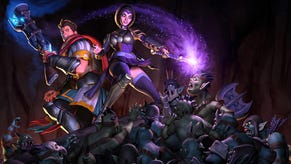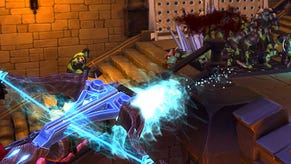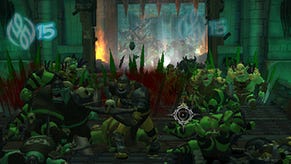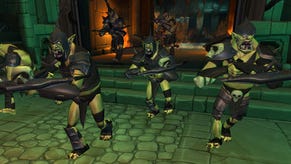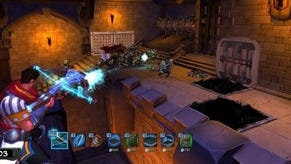Wot I Think: Orcs Must Die
And their gnolls and ogres and kobolds too
Orcs Must Die is the first game from Robot Entertainment, the studio raised from the ashes of Age of Empires dev Ensemble, and it was released on PC (via Steam) yesterday. It is a tale of many, many, many Orcs, and of their very, very, very regular deaths. And this? This is what I think of it.
First and most important point: Orcs Must Die is not a victim of Space Marine Syndrome. The demo does not tell all its tales, and instead this grows and builds and changes as it should, even though you're inherently doing the same thing throughout. You can probably guess what that thing is. No, it doesn't involve hugs. Well, unless your kind of hug involves wall-mounted mechanised blades.
OMD is a synthpop group from the 1980s. It also, more or less, a tower defence game played from a frantic, all-action third-person perspective. There's a reasonably critical difference from those turret-building strategy games, however, and that's that you're very rarely creating the path that you want to usher the endless legion of openly stupid orcs (and gnolls and kobolds and goblins and ogres) down, not doing that precise calculation of what goes exactly where and how to make them loop back on themselves and have your cannon stick a second round in their arses as they pass by again.
No, instead it's about spending more or less wisely on as many traps, upgrades and defensive archers and paladins as you can, then unleashing as much on-the-spot hell as you can with what you've got. This is not about strategy, but about contained carnage. Most of all because you're in the mix yourself, slaying the orcs that your traps don't catch with crossbow, with blade and with assorted overpowered magic.
Every couple of levels, you're granted a new type of trap: some simply more devestating than the last (and appropriately more expensive too), others aimed at trying to co-ordinate the endless green rush into massed groups all the better for efficient squishing/eviscerating. Really, though, there's very little of the latter: there's a couple of slow-down traps and few that can slam a group of orcs elsewhere in the map, but generally that slow-down will be so that you can hack them to pieces and that elsewhere will be a enormous lava pit. The only type of threat management that really matters here is killing, killing, killing and killing some more. Yes, while the stern mandate is that the orcs must die, perhaps a more accurate title is Orcs Must Die Because It Is Funny. This is a positively sadistic game in a positively cartoon vein, and not even the victims of all that murdering take it particularly seriously.
The wall-blades, the ceiling crushers, the auto-crossbow turrets, the floorspikes, the grinders, the magma pits... Sure, after a time it becomes a blur of red and green and comicbook bubbles showing how much cash the most recent mass slaying has netted you, but an effective configuration grants you a few seconds of respite, which you'll spend simply watching the improbable scale of slaughter, listening to the grumpy, Grimlock-like moaning of the about-to-be-slain and planning what you can build next.
Such complacency rarely lasts long past the first few levels (presuming you opt for the 'Warmage' middle difficulty rather than the too-easy 'Apprentice' setting), because the orcs have just enough tricks up its sleeve to tear a short-term plan apart in moments. The everyday Orcs - stupid, cowlike things that known how to charge and attack but would clearly rather not have to - aren't too much of a threat unless you've been a total moron, but a Kobold rush might prove too fast for your traps, a Gnoll Warrior will zero in frighteningly on your melee-helpless Archer Champions, an Armoured Ogre will rush straight to you and thump your brain out of your ears if you can't get out of the way in time. And generally they'll achieve this by rushing out from multiple entrances at the same time as you use the level's fast-travel portals to desperately try and cover every approach, to stop them from reaching the Rift that will transport them to the realm of humanity where they'll do, um, something.
Ach, what I'm trying to say is that OMD becomes really rather hard. Good hard, not bad hard - but it does mean that the impression you might have got from the demo, that it's quite the cakewalk, is waaaaaay off. The game can throw so much at you and so fast, and if you don't have the wherewithal or the tools to keep up, you're going down. In fact, about halfway through I had to step down the difficultly - but I know I'll be back to tackle those levels at a big-boy level of challenge, armed with more traps and more upgrades.
What I most celebrate about OMD is their 1980 single Enola Gay. And what I most celebrate about OMD the game is that it's refreshingly non-didactic about which traps I should use. Find a preferred few traps, attacks or backup units and, presumingly you're reasonably sensible about where and when you place them, they'll stand you in good stead for most of the game, with your base strategy evolving as something you also fancy gets unlocked. There are traps and spells I pretty much didn't bother with outside of initial experimentation, as the tech tree is far more about choice than about trap x being x percent more deadly than trap y.
There's even a secondary per-level upgrade system, the Weavers, wherein you pick a temporary clutch of upgrades to optionally buy instead of/as well as your traps. If you're all about killing the orcs yourself, then you'll want the one that buffs your health and sets your weapons on fire; if you're all about traps you can improve their recharge time and make 'em work on the hulking ogres; if you're all about spells then there's mana-improving stuff; if you rely on archers and paladins, you can pour money into making them hardier and biff-ier. It's not key in lock stuff: it's about indulging your own sadistic interests.
It is repetitive, but not unhappily so, plus I know I can revisit it using different traps and upgrades to have a reasonably different time (particularly, I've not played with the traps that hurl orcs into the air/lava, instead favouring instant evisceration in some form). It's got that dark, just-one-more-go alchemy to it, plus the pull of what trap you might be given next, as well as the guilty sense that you could have done better and perhaps you should. But it is pop, throwaway stuff that certainly won't make you feel as though you've explored the darkest, most strategic reaches of your brain: it is as serious as its silly name clarion-calls.
What surprised me was how much I came to enjoy the dialogue, given the few repeated snippets of it in the demo seemed so irritating. Sure, your character has still spent far too much time worshipping at the Evil Dead shrine, but some neat one-liners creep in there, especially when he's snarkily impersonating his hoary old master or bickering with the unseen orchestrator of the orc invasion. I could do with the cheesy, repeated fatality celebrations being turned off, but for the most part the voicework's as likeable as the game itself. Which is how likeable? Very likeable. Despite its genocidal stylings, Orcs Must Die is about as good-natured a game as I've played this year: a one trick pony that makes the absolute best of what's a very good trick indeed.







